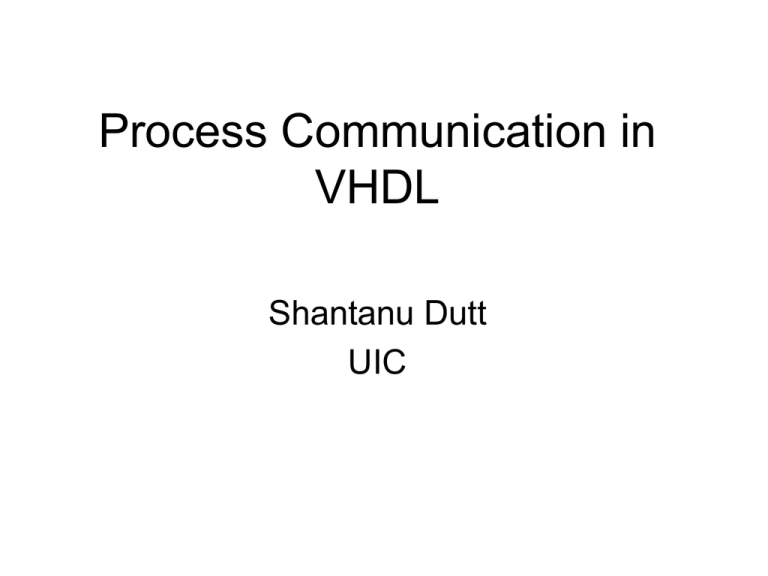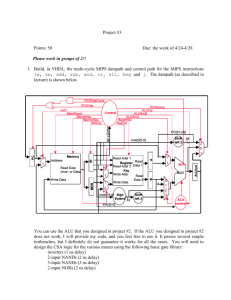ppt
advertisement

Process Communication in VHDL Shantanu Dutt UIC Inter-Process Communication in VHDL entity xyz is port (start: in std_logic; f: out std_logic); end entity xyz; Architecture signal x, z: std_logic; start (control) Note: wait statements are event driven, i.e., are evaluated only when at least 1 event occurs on one of the signals in the wait statement (for “wait on” and “wait until” statements) OR when a time expiry event happens for the “wait for” statement. z (control + data) wait until start = `1’ and last_value’start=‘0’; if (n <= m) then z <= ‘0’ after 6 ns; else z <= ‘1’ after 6 ns; end if; Processes wait on z; x <= (a xor b) nand z after 4ns; x (control only) wait until x = ‘1 y := (a1 xnor b1) xnor (c1 xnor d1); f <= y nand u after 2 ns; f Microprocessor-Memory Communication CPU-Mem First-cut behavioral description: entity cpu-mem is port(read, write: in std_logic; DR: in word; ARin: in integer; IR: out word); -- DR: data to write, ARin: its address, IR: instruction read end entity cpu-mem; Shantanu Dutt, UIC data_read CPU-Mem Interface data_write data_in dr 3 2 PC +2 AR 5 address 4 data_out Memory read write architecture behav_high of cpu-mem is ir 6 begin mem_ready all_in_one: process (read, write) is type data_type is array (0 to 63) of word; 1 DR ARin IR 6 variable store: data_type; Legend: dr: data_reg variable addr, AR, PC: integer; ir: instr_reg variable data_reg, instr_reg, data_in, data_out : The red arrows w/ #s show the word; seq. of operations (or of begin 1 signals that need to be CPU if read = ‘1’ then generated to cause the 2 AR := PC; addr := AR; 3 operations). Relate this seq. 4 data_out := store(addr/2); to the seq. of opers described • Very high-level description 5 instr_reg := data_out; in the VHDL code on the left. • No description of module communication 6 IR <= instr_reg after 1 ns; • Data/address/control-signal propagation delays are thus not obviously visible 6 PC := PC + 2; • Though some of these delays (not all) could be modeled by “wait for ..” statements elsif write = ‘1’ then • E.g., if 1-way commun. time w/ memory is 2 ns, and it takes 1 ns for the mem. AR := ARin; controller to access the data store, as well as for the CPU-mem interface to write to addr := AR; a reg. then the delay of 2+1+2 = 5 ns to read an instruction from memory and store data_reg := DR; in the IR can be modeled as: data_in := data_reg; • data_out := store(addr/2); (the 0 delay model) (a non-zero delay model) store(addr/2) := data_in; end if; wait for 5 ns; data_out := store(addr/2); end process cpu-mem; • A better behavioral description modeling various timing & comm. issues given next end architecture behav_high; read write architecture behav_detailed of cpu-mem is Microprocessor-Memory Communication (contd): signal address: integer; signal data_in, data_out : word; A more detailed behavioral description signal data_read, data_write, mem_ready: std_logic := `0’; Shantanu Dutt, UIC begin CPU-Mem CMI: process is -- CPU-Memory Interface module 6 6’ data_read variable AR, PC : integer; variable data_reg, instr_reg: word; 3 3’ begin CPU-Mem data_write wait until read = ‘1’ or write = ‘1’; Interface 1 if read = ‘1’ then data_in dr 2 AR := PC; wait for 1 ns; -- 1 ns reg. acc. time 3 2 3’ 3 address <= AR after 2 ns; -- 2 ns prop. delay Memory PC address AR 3 data_read <= `1’ after 2 ns; -- 2ns prop. delay; note simult. w/ addr 4’ 4 4’ wait until mem_ready = ‘1’; 5 +2 data_out 5 instr_reg := data_out; wait for 1 ns; 6 IR <= instr_reg after 1 ns; ir 7’ 7 8 6 data_read <= `0’ after 2 ns; 4’ mem_ready 4 7’ wait until mem_ready = `0’; 8 PC := PC+2; wait for 1 ns; 6 1 elsif write = ‘1’ then data_reg := DR; AR := ARin; DR ARin IR Legend: dr: data_reg wait for 1 ns; -- 1 ns reg acc (both happening in parallel) ir: instr_reg address <= AR after 2 ns; data_in <= data_reg after 2 ns; The red arrows w/ #s show the seq. of operations (or of data_write <= ‘1’ after 2 ns; corresp. signals). For a # j, j’ …………………… end if; end process CMI; denotes the delayed version of CPU the corresp. signal Relate this Memory: process is seq. to the seq. of opers type data_type is array (0 to 63) of word; described in the VHDL code on variable store: data_type; variable temp_reg: word; the left. 2ns reg + 1ns reg (PC) variable addr: integer; RAM access 2ns prop. access delay begin 2ns prop. delay delay wait until data_read = `1’ or data_write = `1’; delay data_read 2ns prop. 3’ if data_read = ‘1’ then – next:1ns reg. & ram access delay for 2ns prop. addr :=address; temp_reg := store(addr/2); wait for 2 ns; read sig. delay mem_ready 4 data_out <= temp_reg after 2 ns; • Multi-process description describing fully responsive handshaking -- RAM r/w time is 1ns; prop. time = 2ns between the CPU-Mem interface (CMI) and Memory modules 4 mem_ready <= ‘1’ after 2 ns; • Most Data/address/control-signal propagation delays and storage 6’ wait until data_read = ‘0’; access times are accounted for: delay parameters used: 1-way commun. 7 mem_ready <= ‘0’ after 2 ns; elsif data_write = ‘1’ then addr := address; store(addr/2) := data_in; wait for 2 ns; ……………… end if; end process Memory; end architecture behav_detailed; time w/ memory = 2 ns, RAM/register r/w time = 1 ns. • Note: A safer form of wait until X = ‘1’ is if X /= ‘1’ then wait until X = ‘1’ when it is not known for sure that X will not be ‘1’ at the point we want to wait for X being ‘1’. Similarly for waiting for X to be ‘0’. Original Code in the Notes for CPU-Mem Communication (w/ typos corrected) data_out data_in , data_read : std_logic; data_out; data_read <= ‘0’; data_out <= store(address/2); store(address/2) <= data_in; mem_ready <= ‘1’;











